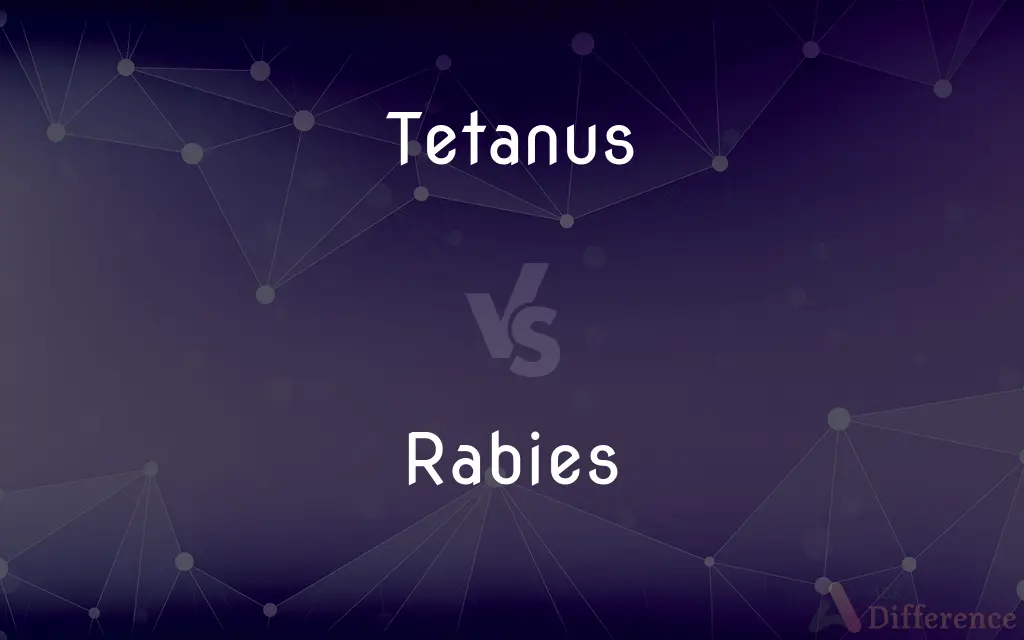Tetanus vs. Rabies — What's the Difference?
Edited by Tayyaba Rehman — By Fiza Rafique — Published on November 13, 2023
Tetanus is a bacterial infection affecting the nervous system, often through wound contamination, while Rabies is a viral disease transmitted primarily through animal bites, affecting the central nervous system.

Difference Between Tetanus and Rabies
Table of Contents
ADVERTISEMENT
Key Differences
Tetanus is a medical condition caused by the bacterium Clostridium tetani. The bacteria produce toxins affecting the nervous system, leading to muscle stiffness and spasms. In contrast, Rabies is caused by the rabies virus and affects the central nervous system, potentially leading to death if not treated promptly.
Both Tetanus and Rabies are preventable through vaccination. Tetanus shots are often administered after injuries or wounds that might be contaminated, especially puncture wounds. On the other hand, Rabies post-exposure prophylaxis (PEP) is administered after potential exposure, such as an animal bite.
Symptoms of Tetanus include muscle stiffness, typically starting in the jaw, earning the nickname "lockjaw." As for Rabies, initial symptoms are flu-like but can evolve into hallucinations, hydrophobia, and paralysis.
While Tetanus infections arise from wound contamination by the bacterium commonly found in soil, Rabies transmission primarily involves animal bites, especially from animals like raccoons, skunks, bats, and foxes.
Both Tetanus and Rabies are serious conditions requiring immediate medical attention. Early intervention and treatment can prevent severe complications, but neglect can result in fatal outcomes for both diseases.
ADVERTISEMENT
Comparison Chart
Causative Agent
Bacterium (Clostridium tetani)
Virus (Rabies virus)
Transmission
Wound contamination, especially puncture wounds
Primarily through animal bites
Symptoms
Muscle stiffness (lockjaw), spasms
Flu-like symptoms, progressing to hallucinations, hydrophobia, and paralysis
Prevention
Tetanus vaccine
Rabies vaccine
Severity
Can be fatal if untreated
Almost always fatal if post-exposure prophylaxis (PEP) isn't administered
Compare with Definitions
Tetanus
A bacterial disease causing muscle stiffness and spasms.
After stepping on a rusty nail, she got a Tetanus shot as a precaution.
Rabies
A viral disease affecting the central nervous system.
He received a Rabies shot after being bitten by a stray dog.
Tetanus
Often referred to as "lockjaw" due to its characteristic symptom.
He couldn't open his mouth because of Tetanus.
Rabies
Often transmitted through the saliva of an infected animal.
Wild animals, especially bats, are common carriers of Rabies.
Tetanus
Commonly associated with wound contamination, especially from soil.
Farmers are particularly at risk of Tetanus due to their exposure to soil.
Rabies
Symptoms can include agitation, hallucinations, and fear of water.
The patient's fear of water was a classic sign of Rabies.
Tetanus
A condition resulting from the toxins of the Clostridium tetani bacterium.
Proper wound care can prevent Tetanus infections.
Rabies
Preventable through vaccination and post-exposure prophylaxis.
Travelers to certain countries are advised to get a Rabies vaccine.
Tetanus
An acute, often fatal disease characterized by spasmodic contraction of voluntary muscles, especially those of the neck and jaw, and caused by the toxin of the bacterium Clostridium tetani, which typically infects the body through a deep wound. Also called lockjaw.
Rabies
If left untreated after exposure, the disease is almost always fatal.
Immediate medical attention after potential Rabies exposure is crucial.
Tetanus
(Physiology) A state of continuous muscular contraction, especially when induced artificially by rapidly repeated stimuli.
Rabies
An acute, infectious, usually fatal viral disease of the central nervous system that is transmitted by the bite of infected animals and occurs in many mammals, including dogs, cats, raccoons, and bats.
Tetanus
A serious and often fatal disease caused by the infection of an open wound with the anaerobic bacterium Clostridium tetani, found in soil and the intestines and faeces of animals.
Rabies
(disease) An infectious disease caused by species of Lyssavirus that causes acute encephalitis in warm-blooded animals and people, characterised by abnormal behaviour such as biting, excitement, aggressiveness, and dementia, followed by paralysis and death.
Tetanus
A state of muscle tension caused by sustained contraction arising from a rapid series of nerve impulses which do not allow the muscle to relax.
Rabies
Same as Hydrophobia (b); canine madness.
Tetanus
A painful and usually fatal disease, resulting generally from a wound, and having as its principal symptom persistent spasm of the voluntary muscles. When the muscles of the lower jaw are affected, it is called locked-jaw, or lickjaw, and it takes various names from the various incurvations of the body resulting from the spasm.
Rabies
An acute viral disease of the nervous system of warm-blooded animals (usually transmitted by the bite of a rabid animal); rabies is fatal if the virus reaches the brain
Tetanus
That condition of a muscle in which it is in a state of continued vibratory contraction, as when stimulated by a series of induction shocks.
Tetanus
An acute and serious infection of the central nervous system caused by bacterial infection of open wounds; spasms of the jaw and laryngeal muscles may occur during the late stages
Tetanus
A sustained muscular contraction resulting from a rapid series of nerve impulses
Tetanus
Preventable through regular vaccination.
Most children receive Tetanus vaccinations as part of their immunization schedule.
Common Curiosities
What animals are most likely to carry Rabies?
In the U.S., bats, raccoons, skunks, and foxes are the primary wildlife reservoirs for Rabies.
Is Rabies only transmitted by dogs?
No, Rabies can be transmitted by various mammals, including bats, raccoons, skunks, and foxes.
Is there a cure for Rabies once symptoms appear?
No, once Rabies symptoms manifest, the disease is nearly always fatal.
What are common symptoms of Tetanus?
Muscle stiffness, especially in the jaw (lockjaw), followed by muscle spasms.
Can you get Tetanus from any wound?
While any wound can potentially lead to Tetanus, deep puncture wounds and cuts are at higher risk.
Can Tetanus be treated after symptoms appear?
While Tetanus can be treated, it's essential to seek treatment immediately as it can be life-threatening.
How long does it take for Rabies symptoms to appear?
It can vary, from weeks to several months, depending on the virus's location and its route to the central nervous system.
How often should one get a Tetanus booster?
Every 10 years, or sooner if there's a high-risk injury.
Are children vaccinated against Tetanus?
Yes, children typically receive Tetanus vaccines as part of their routine immunizations.
How soon should one receive treatment after potential Rabies exposure?
Ideally, within 24 hours for the best protection.
Share Your Discovery

Previous Comparison
Lead Acid Battery vs. Alkaline Battery
Next Comparison
Potassium Chloride vs. Potassium PhosphateAuthor Spotlight
Written by
Fiza RafiqueFiza Rafique is a skilled content writer at AskDifference.com, where she meticulously refines and enhances written pieces. Drawing from her vast editorial expertise, Fiza ensures clarity, accuracy, and precision in every article. Passionate about language, she continually seeks to elevate the quality of content for readers worldwide.
Edited by
Tayyaba RehmanTayyaba Rehman is a distinguished writer, currently serving as a primary contributor to askdifference.com. As a researcher in semantics and etymology, Tayyaba's passion for the complexity of languages and their distinctions has found a perfect home on the platform. Tayyaba delves into the intricacies of language, distinguishing between commonly confused words and phrases, thereby providing clarity for readers worldwide.
















































